 | |
CCLA Server Chess | |
| Copyright © 2005– by CCLA. All rights reserved. |
| [top] |
Depending upon your processor and internet connection speeds, game files may take several seconds to load in the pgn viewers. The blank chess boards will populate when ready for viewing. Credit is given for examples taken from actual tournament games. Otherwise, positions have been composed for this web page. |
25 Standard |
|
• Anastasia's Mate • Anderssen's Mate • Arabian Mate • Back Rank Mate • Blackburne's Mate • Boden's Mate • Damiano's Mate • Damiano's Bishop Mate • David & Goliath Mate • Dovetail Mate • Epaulette Mate • Fool's Mate • Greco's Mate • Gueridon Mate • Hook Mate • Legal's Mate • Lolli's Mate • Max Lange's Mate • Minor Piece Mate • Morphy's Mate • Opera Mate • Pillsbury's Mate • Reti's Mate • Scholar's Mate • Smothered Mate |
1. Anastasia's Mate |
 |
| Theory Position after Rh4# |
| PGN Viewer courtesy of ChessTempo |
| Bayer-Falkbeer, Vienna 1852 |
| Position after 22. Kh1 ... |
| More examples of Anastasia's Mate. |
| [Index] |
2. Anderssen's Mate |
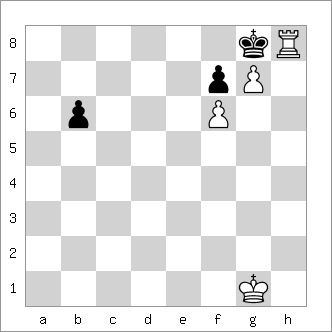 |
| Theory Position after Rh8# |
| PGN Viewer courtesy of ChessTempo |
| Anderssen - Zukertort, Barmen 1869 |
| Position after 29. Qxh7+ ... |
| More examples of Anderssen's Mate. |
| [Index] |
3. Arabian Mate |
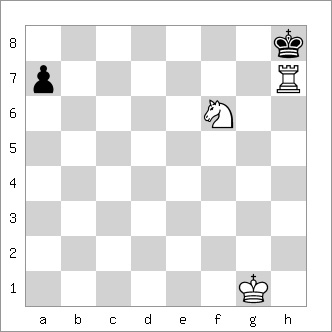 |
| Theory Position after Rh7# |
| PGN Viewer courtesy of ChessTempo |
| Kotronios - Vallejo Pons, Budva 2009 |
| Position after 41 ... Rd1? |
| More examples of Arabian Mate. |
| [Index] |
4. Back Rank Mate |
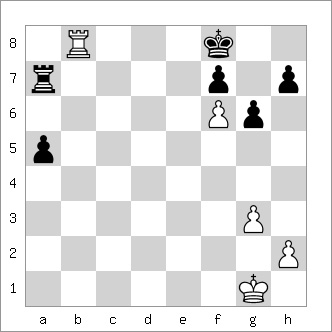 |
| Theory Position after Rb8# |
| PGN Viewer courtesy of ChessTempo |
| Alekhine - Frieman, New York 1924 |
| Position after 22 ... Qxf6 |
| More examples of Back Rank or Corridor Mate. |
| [Index] |
5. Blackburne's Mate |
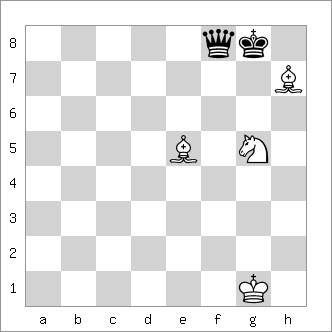 |
| Theory Position after Bh7# |
| PGN Viewer courtesy of ChessTempo |
| NN - Blackburne, England 1880 |
| Position after 13. Qxa8? ... |
| More examples of Blackburne's Mate. |
| [Index] |
6. Boden's Mate |
| Horwitz - Popert, Hamburg 1844 |
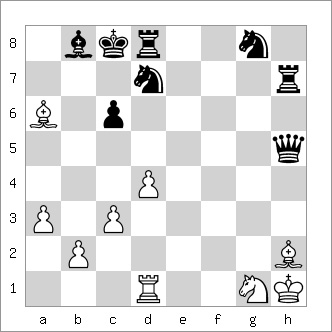 |
| Theory Position after Ba6# |
| PGN Viewer courtesy of ChessTempo |
| Schulden - Boden, London 1853 |
| Position after 14. Bxd5 ... |
| More examples of Boden's Mate. |
| [Index] |
7. Damiano's Mate |
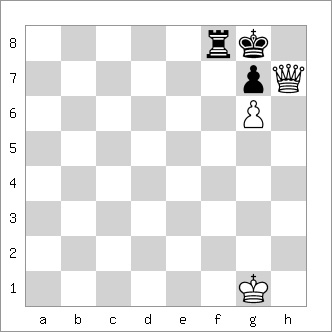 |
| Theory Position after Qh7# |
| PGN Viewer courtesy of ChessTempo |
| Blackburne - NN, Hastings 1894 |
| Position after 13. ... Kxh8 |
| More examples of Damiano's Mate. |
| [Index] |
8. Damiano's Bishop Mate |
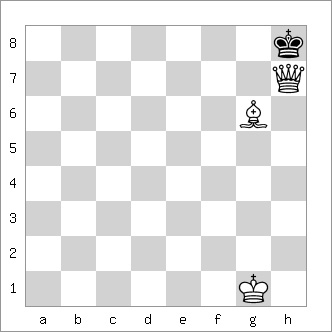 |
| Theory Position after Qh7# |
| PGN Viewer courtesy of ChessTempo |
| Makovetz - Charousek, Budapest 1895 |
| Position after 26. ... Bh3 |
| More examples of Damiano's Bishop Mate. |
| [Index] |
9. David & Goliath Mate |
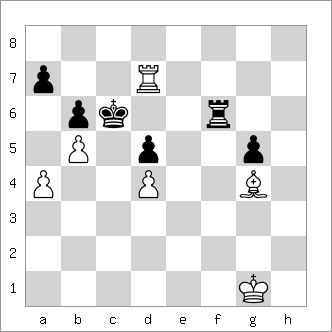 |
| Theory Position after b5 # |
| PGN Viewer courtesy of ChessTempo |
| Alekhine - Verlinsky, Odessa 1918 |
| Position after 38. ... Rg6 |
| More examples of David and Goliath Mate. |
| [Index] |
10. Dovetail Mate |
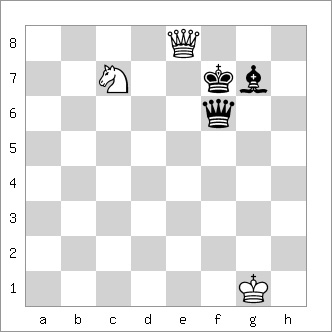 |
| Theory Position after Qe8# |
| PGN Viewer courtesy of ChessTempo |
| Szily - Bronstein, Budapest 1949 |
| Position after 37. Bf2 ... |
| More examples of Dovetail Mate. |
| [Index] |
11. Epaulette Mate |
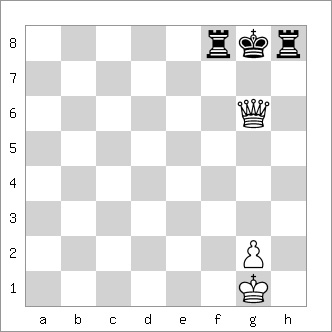 |
| Theory Position after Qg6# |
| PGN Viewer courtesy of ChessTempo |
| Tarrasch - Chigorin, St. Petersburg 1893 |
| Position after 24 ... Rf8 |
| More examples of Epaulette Mate. |
| [Index] |
12. Fool's Mate |
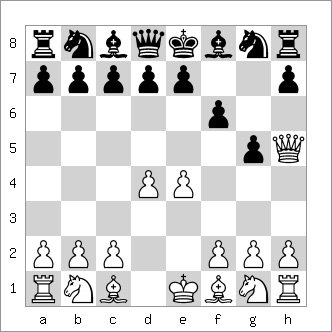 |
| Theory Position after 1. e4 g5 2. d4 f3??? 3. Qh5# |
| PGN Viewer courtesy of ChessTempo |
| Teed - Delmar, New York 1896 |
| Position after 6. ... Rh6? |
| More examples of Fool's Mate. |
| [Index] |
13. Greco's Mate |
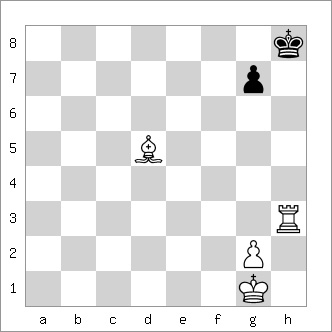 |
| Theory Position after Rh3# |
| PGN Viewer courtesy of ChessTempo |
| Euwe - Wiersma, Amsterdam 1920 |
| Position after 18. ... Be6 |
| More examples of Greco's Mate. |
| [Index] |
14. Gueridon Mate |
| (pedestal mate, swallow's tail mate.) |
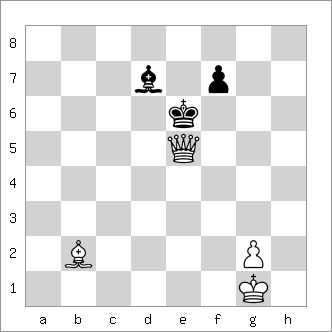 |
| Theory Position after Qe5# |
| PGN Viewer courtesy of ChessTempo |
| Keres - Fischer, Bled 1959 |
| Position after 52. ... g4 |
| More examples of Gueridon Mate. |
| [Index] |
15. Hook Mate |
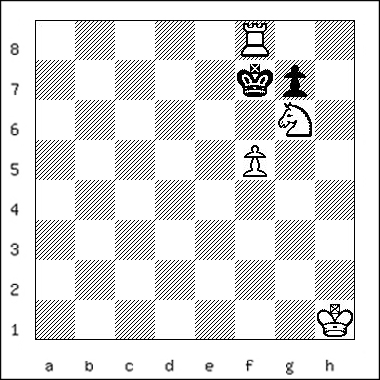 |
| Theory Position after Rf8# |
| PGN Viewer courtesy of ChessTempo |
| Marshall-Napier, New York 1898 |
| Position after 49. ... Qd1 |
| More examples of Hook Mate. |
| [Index] |
16. Legal's Mate |
| Kermur Sire De Legal - Saint Brie, Paris 1750 |
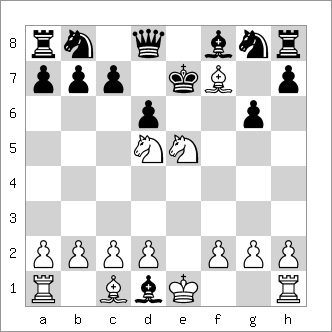 |
| Theory Position after 7. Nd5# |
| PGN Viewer courtesy of ChessTempo |
| Pillsbury - Fernandez, Havana (Simul) 1900 |
| Position after 7. ... Bxd1 |
| More examples of Legal's Mate. |
| [Index] |
17. Lolli's Mate |
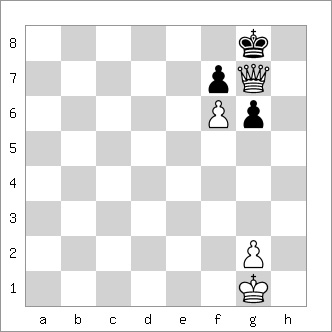 |
| Theory Position after Qg7# |
| PGN Viewer courtesy of ChessTempo |
| Kushnir - Zatulovskaya, Beltsy 1970 |
| Position after 35. ... Qg4 |
| More examples of Lolli's Mate. |
| [Index] |
18. Max Lange Mate |
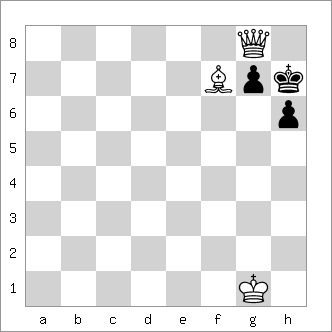 |
| Theory Position after Qg8# |
| PGN Viewer courtesy of ChessTempo |
| Anderssen-Lange, Breslau 1859 |
| Position after 32. ... g6 |
| More examples of Max Lange's Mate. |
| [Index] |
19. Minor Piece Mate |
 |
| Theory Position after Nh7# |
| PGN Viewer courtesy of ChessTempo |
| Maczynski - Pratten, Portsmouth 1948 |
| Position after 19. Qxh8 ... |
| More examples of Minor Piece Mate. |
| [Index] |
20. Morphy's Mate |
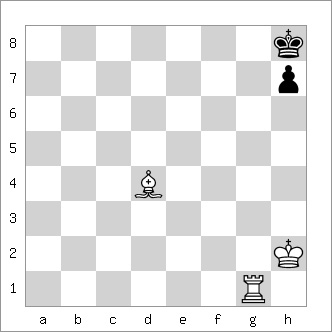 |
| Theory Position after Bd4# |
| PGN Viewer courtesy of ChessTempo |
| Reshevsky - Shainswit, New York 1951 |
| Position after 28. ... exd3? |
| More examples of Morphy's Mate. |
| [Index] |
21. Opera Mate |
 |
| Theory Position after Rd8# |
| PGN Viewer courtesy of ChessTempo |
| Morphy - Duke Karl of Brunswick and Count Isouard, Paris 1858 |
| Position after 15. ... Nxd7 |
| More examples of Opera Mate. |
| [Index] |
22. Pillsbury's Mate |
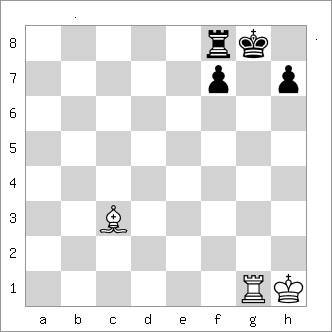 |
| Theory Position after Rg1# |
| PGN Viewer courtesy of ChessTempo |
| Pillsbury - Newman, Philadelphia 1900 |
| Position after 16 ... Qxg2 |
| More examples of Pillsbury's Mate. |
| [Index] |
23. Reti's Mate |
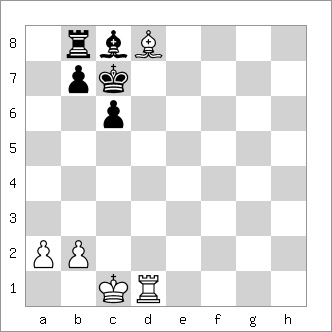 |
| Theory Position after 11. Bd8# |
| PGN Viewer courtesy of ChessTempo |
| Reti - Tartakower, Vienna 1910 |
| Position after 8 ... Nxe4? |
| More examples of Reti's Mate. |
| [Index] |
24. Scholar's Mate |
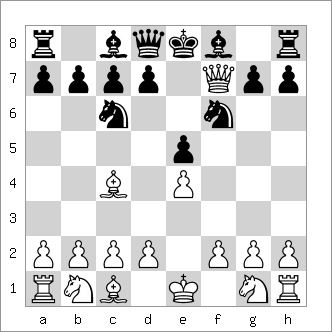 |
| Theory Position after Qxf7# |
| PGN Viewer courtesy of ChessTempo |
| Amillano - Loefflar, Mar del Plata 1972 |
| Position after 4. ... Nd4? |
| More examples of Scholar's Mate. |
| [Index] |
25. Smothered Mate |
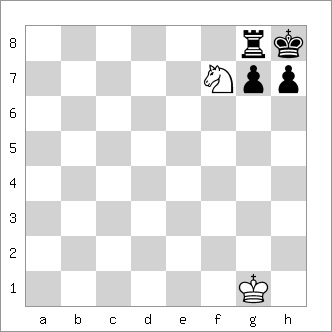 |
| Theory Position after Nf7# |
| PGN Viewer courtesy of ChessTempo |
| Grischuk - Ponomariov, Torshavn 2000 |
| Position after 25. ... Rxd8 |
| More examples of Smothered Mate. |
| [Index] |
| [top] |
Historical Names of | |||||
In addition to the four basic checkmates covered in How to Play Chess, twenty-five standard (named) checkmates are presented on this web page. There are other checkmates documented in chess literature. Some checkmates have more than one name, others are variations on a theme (the Cozio Mate is just the Dovetail Mate turned upside down.) The Gueridon (French for "pedestal table") Mate is also (obviously) known as the "pedestal" mate and also the "swallow's tail" mate. The ubiquitous "back rank" mate is called a "corridor" mate by many authors. The names are not important. What's crucial is understanding and memorizing these patterns so they will be recognized when they're about to occur in a player's own games. These checkmate themes are not confined to chess problems and puzzles. As will be seen, they occur in the games of grandmasters and even world champions, past and present! | |||||
Each checkmate's theoretical pattern is presented as a diagram, with an example from an actual game (live pgn viewer.) It is suggested that students set-up and play through these checkmates from black's viewpoint as well. Most difficult of all is recognizing patterns when they occur horizontally (i.e., rotated 90-degrees) from the normal orientation (the great Keres likely stumbled into a Gueridon Mate because Fischer had "upset his table" (see example.) The key to each pattern is the status of the squares surrounding the king: which ones are obstructed, which are potential flight squares that can be controlled with the pieces available. Players are advised to know these patterns forward, backward and upside down! | |||||
Novice players often complain they are unable to inflict these checkmates on their opponents, that opponents spot the threat and find a defensive move to prevent mate. Part of the reason is choice of openings; double KP openings are not popular today and the closed formations of the QP openings do not create as many open lines and potential mating attacks. Knowledge of the game and defensive skill of today's players, even at the amateur level, is much greater than what existed a hundred and fifty years ago. Players should remember Nimzovich's advice: "A threat is stronger than its execution." A threatened mate can force an opponent to make a defensive move that may compromise his position elsewhere. The knowledgeable player uses a mating threat as one more tactic to gain an advantage. Just like knowledge and skillful use of the 24 Basic Tactics in chess, a mate threat can be a potent tactical weapon in a player's arsenal. | |||||
One of the critical elements of position analysis is king safety, both one's own king and the opponent's. Armed with knowledge of checkmate patterns, players can be alert for opportunities to bring their games to a speedy conclusion (or prevent a disaster if they find themselves under such pressure). Frequently these mating possibilities occur king-side, because players typically castle on that wing, or else in the middle of the board due to a player's failure to castle. An exception is Boden's Mate, peculiar to positions involving queen-side castling. | |||||
Boden's Mate is exceptional for another reason. Apparently it should be called Horwitz' Mate, as Bernard Horwitz played the seminal game (Horwitz-Popert, Hamburg 1844) nine years before Schulden-Boden, London 1853. This historical "fact" can only be inferred, as the position had been published in the Chessplayer's Chronicle of May, 1847 with the players' names but not the game score, tournament or date. The Horwitz-Popert position (again, sans gamescore) was later found in the Schachjahrbuch (Chess Yearbook) for 1894, p. 108, which gave the playing site and date as Hamburg, 1844. | |||||
| |||||
A further complication is the existence of another Horwitz-Popert game score, also Hamburg 1844, a victory by Horwitz with the white pieces
having absolutely nothing to do with a "Boden's Mate;" see volume two of Aus Vergangenen Zeiten (From Times Past,) pp. 167-168
by L. Bachmann (Berlin, 1922.) If Hamburg, 1844 was a double round robin, it's highly unlikely Howitz would have had the white pieces twice.
Horwitz and Josef Kling co-authored Chess
Studies in 1851, a classic work on the endgame. More's the pity the checkmate Horwitz first played was named after someone else.
Horwitz also played a Reti Mate decades before Reti (see Schulten-Horwitz, London 1846). | |||||
Anderssen-Suhle | |||||
1. e4 e5 2. Nf3 Nc6 3. Bc4 Bc5 4. b4 Bxb4 5. c3 Bc5 6. O-O d6 7. d4 exd4 8. cxd4 Bb6 9. d5 Na5 10. Bb2 Nf6 11. Bd3 Bg4 12. Nc3 c6 13. Ne2 O-O 14. Qd2 Rc8 15. Qg5 Bxf3 16. gxf3 cxd5 17. Kh1 Nc4 18. Rg1 Ne8 19. Qxg7+ Nxg7 20. Rxg7+ Kh8 21. Rg8+ Kxg8 22. Rg1+ Qg5 23. Rxg5#. | |||||
| Position after 23. Rxg5# | |||||
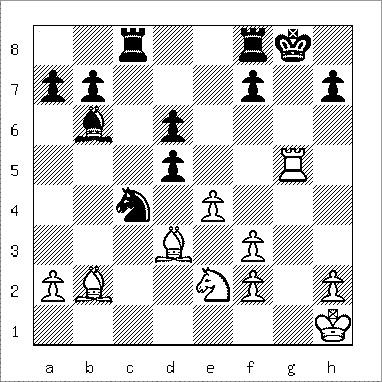 | |||||
| "Pillsbury's Mate" | |||||
| [top] | |||||